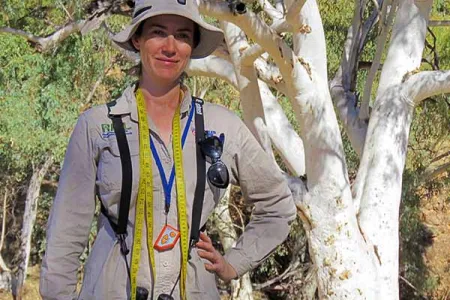Delegates to hear of fire risk to bat habitat
A Charles Darwin University researcher from Alice Springs will speak about the secret lives of Central Australia’s microbats at a gathering of bat experts in Thailand next week.
Ecologist Erin Westerhuis, who has been studying the behaviour of Central Australia’s bats for her PhD thesis, will tell delegates at the International Bat Research Conference in Phuket of the threat that fire poses to bat habitat in arid Australia.
“Ten of the 12 species known in Central Australia are dependent on tree hollows for roosting and breeding,” Ms Westerhuis said.
“The river red gum (Eucalyptus camaldulensis) is the only tree in our rivers with enough hollows, but they are being degraded on a regional scale by increasing wildfire frequency and intensity, fuelled by the invasive buffel grass.
“These large hollow-bearing trees are particularly at risk of destruction in fire, which has the potential to impact adversely on bat populations.”
Ms Westerhuis has spent two years investigating bat activity in 12 rivers and creeks and a further 12 neighbouring vegetation communities.
“We captured about 38,000 vocalisations using an ultrasonic detector that records the echolocation of calls made by a bat when they fly past a microphone.
“Of those we were able to identify – about 33 per cent – we are able to say that half the recordings belong to just three species.”
Ms Westerhuis said there was still much to learn about the sounds that bats make.
“If we can work out what their social calls mean, we may uncover a valuable bioindicator,” she said.
“Perhaps this is an opportunity for citizen scientists; affordable ultrasonic equipment is available on the Internet. I’d encourage anyone with an interest to see what they can find out.”
